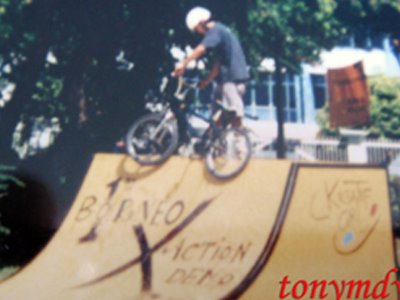Skateboarding safety tips from Publication Number 93 of the United States Consumer Products Safety Commission.
| SAFETY TIPS FOR USING A SKATEBOARD
The U.S. Consumer Product Safety Commission offers the following suggestions for safe skateboarding:
Never ride a skateboard in the street. Don't take chances:
Complicated tricks require careful practice and a specially designed area Only one person per skateboard Never grab onto a car, bus, truck or bicycle Learning how to fall helps reduce your chances of being seriously injured:
If you are losing your balance, crouch down on the skateboard so that you will not have so far to fall. In a fall, try to land on the fleshy parts ofyour body. If you fall, try to roll rather than absorb the force with your arms. Even though it may be difficult, during a fall try to relax your body, rather than stiffen. |
Reprinted courtesy of the U.S. Consumer Products Safety Commission
Skateboarding is a great way to be physically active and develop balance and coordination. Its popularity has been climbing steadily since 1999, and so have the number of injuries resulting from it.
The Children's Hospital of Eastern Ontario (CHEO) reports that between 1997 and 2001 over 350 school-aged children and youth had skateboard related injuries and that the annual rate of skateboard related injury nearly doubled during that five-year period.
Over half (52 per cent) of the injuries were broken bones and dislocations of the arm or leg.
Seven per cent (7 per cent) were head injuries often the most serious and potentially life altering injuries.
Twenty-one per cent (21 per cent) were strains and sprains and 21 per cent were less serious scrapes, cuts and bruises.
Injury rates increase in youth 13 years of age and up.
Skateboard Parks
Children and youth who skateboard in the streets are at increased risk of being hit by a motor vehicle. The injuries sustained from being hit are typically severe, including head injuries. Skateboard parks are safer places to skateboard. While they remove the risk posed by motor vehicles, they present other risks. The tricks performed on the ramps and rails can lead to injuries, as can colliding with other skateboarders. If you choose to go to a skateboard park:
Go to a supervised skateboard park, or one where an adult/parent is present. If this is not possible, go with a buddy. If an emergency arises, help will be easier to find.
Check out the skateboard park to find out the level of skaters using the park, and if BMX biking (stunt bike riding) or in-line skating occurs. A mixture of activities can be dangerous.
Have a look at the ramps and rails to make sure they are safe and secure. Also check that the riding surfaces are free from holes and debris.
Skateboarding Safety Tips
Immerging research is indicating that skateboarding, when compared to other recreational activities, has a lower rate of injuries. This rate can be even lower by following skateboarding safety tips.
Wear the gear! Get a certified helmet that fits snugly, and is done up tightly under the chin.
Wear elbow and knee pads to prevent scrapes and cuts.
Wear wrist guards to prevent wrist fractures.
Wear slip resistant shoes with a closed toe.
Make sure the skateboard is in good working order (no loose, broken or cracked parts, non-slip surface on board, no sharp edges).
A Note on Helmets
Currently, manufacturers are not required to meet any safety standards for skateboarding helmets. Make sure to get a helmet that meets one of the following standards:
When in a skateboard park, wear a helmet that is American Society for Testing and Materials (ASTM) F-1492 or Snell N-94 certified. They are made for multiple impacts.
A Consumer Product Safety Commission (CPSC) certified helmet is safe for skateboarding (and bicycling), but must be replaced after one major blow to the helmet (which happens often in a skatepark).
Get Trained!
Children should learn how to fall safely. They should also avoid trying to perform tricks beyond their skill level. Many local community and recreational centers in the City of Ottawa run skateboarding camps for various skill levels. Contact a local community centre for more information.



































